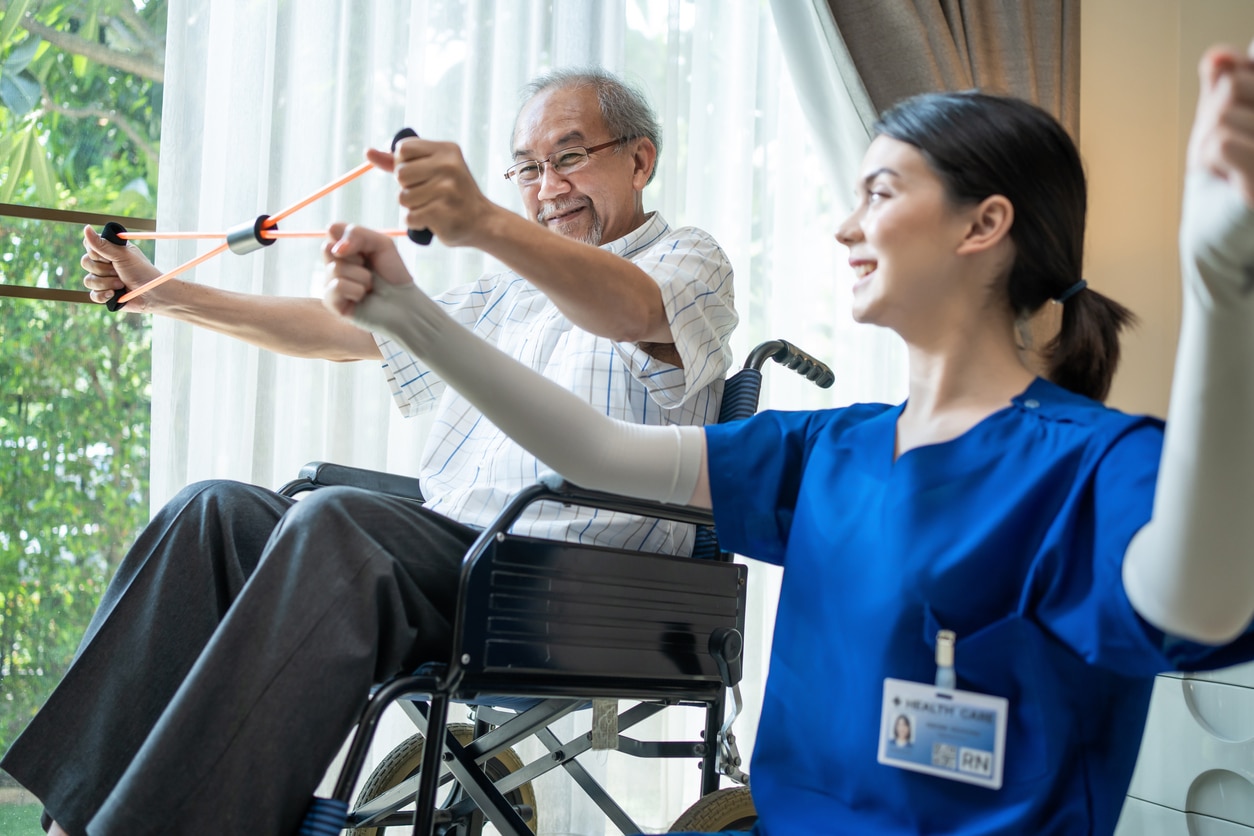Physical therapy (often called PT) is generally considered a necessary part of recovery from an injury or illness. But regular physical therapy for seniors is also a great option for helping them stay mobile, agile and independent simply because it strengthens muscles, improves balance, increases endurance, and can even reduce pain from conditions like arthritis. Don’t wait until an injury occurs, take a look at what physical therapy for seniors has to offer!
Which type of physical therapy is right for you?
There are many specialized types of physical therapy but the most common for seniors are geriatric, orthopedic and cardiopulmonary physical therapy:
For seniors who want to fight back against aging, geriatric physical therapy addresses a broad range of concerns including recovery from surgery, cancer treatment, arthritis, osteoporosis, and balance disorders. Geriatric physical therapy is designed specifically for older adults and is usually provided on an outpatient basis either in a clinic or at home.
Orthopedic physical therapy is the most commonly performed for recovery from musculoskeletal system injury or surgery and focuses on building the strength of muscles, ligaments, joints and tendons to enable healing and restore range of motion and flexibility. Orthopedic physical therapy can also help seniors manage arthritis, bursitis, cancer, joint and back pain, scoliosis, and other painful and debilitating conditions and diseases.
Cardiopulmonary physical therapy focuses on the heart and lungs and is typically prescribed for people with coronary heart disease, congestive heart failure, chronic obstructive pulmonary disease (aka COPD), lung cancer, and asthma. This physical therapy often includes lifestyle changes such as quitting smoking, reducing salt consumption and other dietary modifications.
Does physical therapy require an injury or illness first?
While many people think of physical therapy as reactive following injury or illness, physical therapy can also be a proactive wellness tool. According to the National Council on Aging article, “How Physical Therapy Can Prevent Health Problems,” seeing a physical therapist can help seniors address physical problems such as declining balance and endurance before they become a problem, as well as addressing other aspects of life like nutrition that factor into their overall wellness goals.
If proactive physical therapy sounds like a good idea, you can get a referral from a physician, but in many states, it’s not mandatory. In fact, the American Physical Therapy Association recommends visiting a physical therapist annually for an assessment to determine how to best maintain and improve health, mobility and independence.
What to expect from physical therapy
Unlike typical exercise routines, physical therapy focuses on goals that improve function in targeted area of the body. Physical therapists will begin with an assessment and an individualized plan designed to address problem areas. According to the NCOA article, “The Role of a Physical Therapist in Healthy Aging,” this involves five primary physical aspects:
- Flexibility
- Strength
- Endurance
- Posture
- Balance
Once problem areas are pinpointed the physical therapist will develop individualized exercises that zero in on those areas to build strength, endurance and flexibility. According to the lifeofpt.com article, “Life in a Day of a Physical Therapist,” these exercises encompass:
- Passive range of motion exercises where someone else moves the body part, such as with a patient who has had a stroke or other paralyzing injury or lacks the strength to do it themselves.
- Active assisted range of motion exercises where the patient is assisted with the exercises.
- Active range of motion exercises where the patient does all the exercises unaided.
- Progressive resistance exercises where the amount of resistance is increased such as with dumbbells or weighted physio balls.
In addition to physical exercises, physical therapists also have other therapeutic tools like those described in the verywellhealth.com article, “12 Common Physical Therapy Treatments and Modalities,” including manual massage, electrical stimulation, traction, and ultrasound.
Value-added benefits of physical therapy
While physical therapy is key to rehabilitation and even injury prevention, there are other benefits as well. One of those is minimizing chronic pain and thus the need for pain medications like opioids, which are addictive and can be dangerous. Another value-added benefit noted in the health.harvard.edu article, “Avoiding knee or hip surgery,” is the potential to prevent the need for surgery and all the time and energy it takes to recover and rehabilitate.
Physical therapy is the first treatment of choice for many conditions, diseases and injuries for a reason — because it works! To find the right physical therapist check out the APTA’s “Find a PT” tool that can define therapists by practice focus and specialty as well as location.
For more information about Countryside, please call Margaret Nagel at (517) 206-5000 or download our brochure to learn about our care levels, cost, and amenities.


